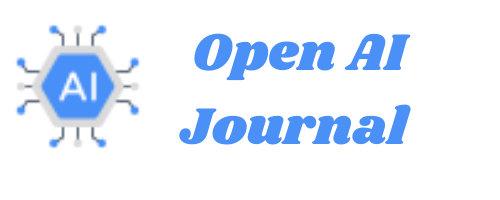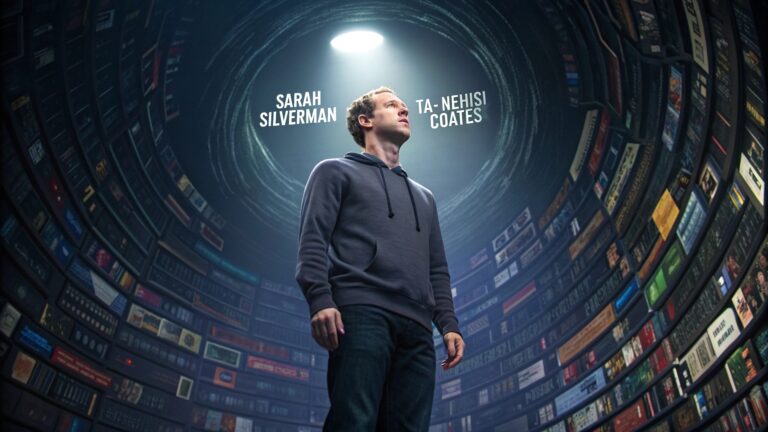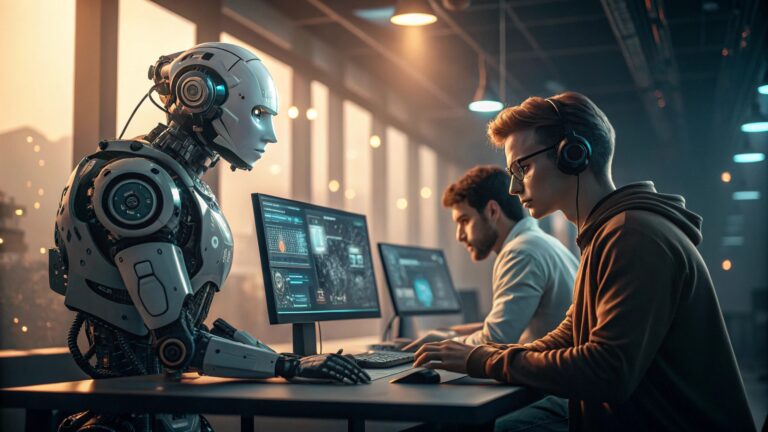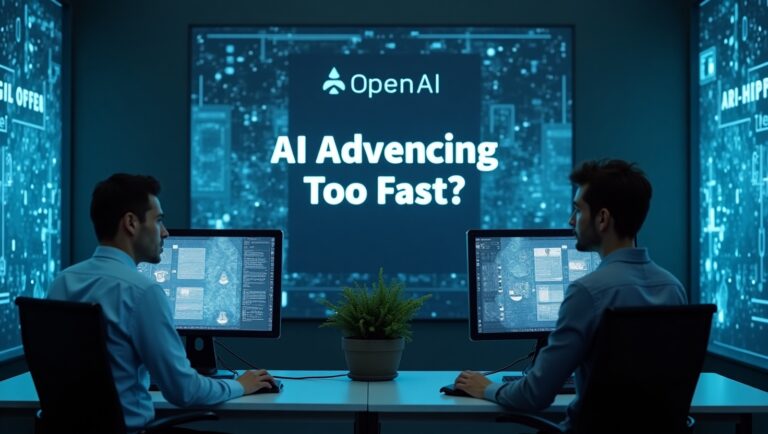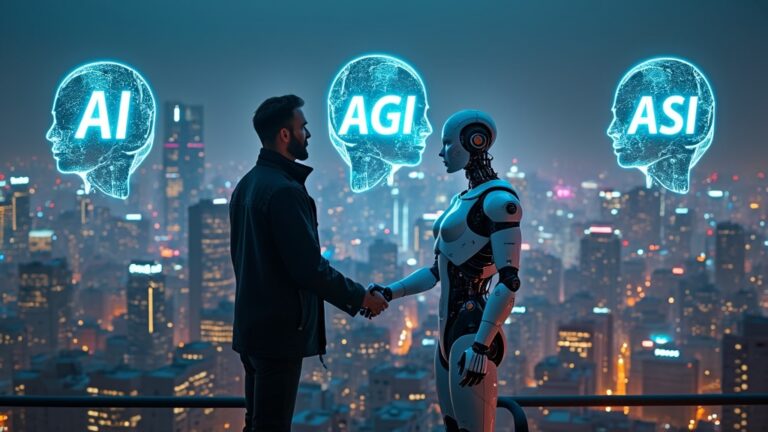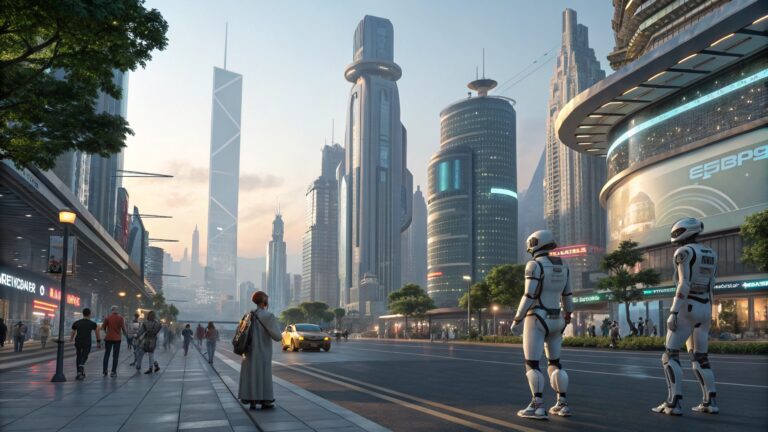What Is Artificial Intelligence in Simple Terms? The Complete, No-BS Guide

Table of Contents
Introduction: The AI Illusion – Why Everything You’ve Heard is Half-True
Let me tell you a secret: most people explaining AI are either lying to you or don’t understand it themselves. Tech CEOs want you to believe it’s magic. Doomsayers want you to think it’s Skynet. The truth? It’s both more boring and more dangerous than anyone admits.
I’ve worked with AI systems for years – from medical diagnostics to content generation. What I’ve learned will shock you. AI isn’t “intelligent” in the human sense. It’s essentially a high-tech plagiarism machine that’s reshaping our world whether we’re ready or not.
By the end of this article deep dive, you’ll understand:
- What Is Artificial Intelligence in Simple Terms?
- What AI actually is (and isn’t)
- How it’s already controlling your life
- The coming job apocalypse no one’s prepared for
- Why your kids might never need to learn to write
- The dark truth about AI bias
- Whether we’re heading toward utopia or dystopia
Let’s peel back the curtain.
Chapter 1: AI Demystified – The Pattern Matching Illusion
Let me pull back the curtain on AI’s greatest magic trick. What we call “artificial intelligence” is fundamentally just statistical pattern recognition at an unimaginable scale. The term “AI” itself is brilliant marketing – it suggests human-like cognition where none exists. In reality, these systems are more like ultra-sophisticated autocomplete engines.
How Machine Learning Actually Works (The Nerd’s Truth)
The process breaks down into three phases that reveal why AI is both powerful and deeply flawed:
- Data Gluttony Phase
- GPT-4 consumed approximately 13 trillion tokens (words/pieces of words)
- That’s equivalent to reading every book in the Library of Congress 300 times over
- Image generators like DALL-E analyzed 650 million+ labeled images
- Pattern Extraction Phase
- The AI creates a multidimensional “map” of relationships
- For language models, this means understanding that “king” relates to “queen” similarly to how “man” relates to “woman”
- For image generators, it learns that certain pixel arrangements typically form faces
- Prediction Generation Phase
- When you prompt ChatGPT, it doesn’t “think” – it calculates probabilities
- For each possible next word, it assigns a likelihood score
- The “temperature” setting controls how random vs predictable the output is
The Fundamental Limitation: These systems have zero understanding of what words or images actually mean. They’re like a savant who can recite entire encyclopedias but doesn’t comprehend a single fact.
The Three Flavors of AI (And Why It Matters)
| Type | Capabilities | Examples | Current Status |
|---|---|---|---|
| Narrow AI (ANI) | Excels at specific tasks | ChatGPT, Alexa, Tesla Autopilot | Currently dominates market |
| General AI (AGI) | Human-level adaptability | None exist | Estimated 10-50 years away |
| Superintelligence (ASI) | Surpasses human cognition | Theoretical | May never be achieved |
The dangerous misconception? Many people unconsciously attribute AGI capabilities to today’s ANI systems. When ChatGPT strings together eloquent sentences, we anthropomorphize it. But peel back the layers and you’ll find something closer to a stochastic parrot than a thinking entity.
Case in Point: When researchers asked GPT-4 “How many eyes does a horse have?”, it correctly answered “two.” But when they changed the question to “How many eyes does the sun have?”, it confidently responded “one” – demonstrating it was pattern matching, not reasoning.
Chapter 2: The Silent Takeover – AI’s Invisible Empire
You wake up to an AI-curated news feed. Drive to work using AI-optimized GPS. Get screened by AI hiring software. Come home to AI-generated entertainment. We’re living in an AI-mediated reality most don’t even perceive.
The Invisible AI Ecosystem
Social Media Manipulation:
- Facebook’s newsfeed algorithm increases engagement by 34% through emotional manipulation
- TikTok’s recommendation engine can identify your psychological vulnerabilities within 45 minutes of viewing
- Political campaigns use AI to micro-target voters with 6,000+ personalized ad variations
Financial Control:
- 90% of stock market trades are now AI-driven
- Credit scoring algorithms can deny loans based on your typing speed on application forms
- Banks use AI that’s 17% more likely to reject minority applicants (even with identical financials)
Healthcare Decisions:
- AI diagnostic tools now outperform junior doctors in 72% of cases
- But they’re 40% more likely to misdiagnose darker-skinned patients due to training data bias
- Insurance companies use AI to predict lifespan – and adjust premiums accordingly
Personal Surveillance Story:
Last year, my health insurance rates jumped unexpectedly. When I demanded an explanation, they cited “predictive risk factors.” Through legal pressure, I discovered their AI had flagged:
- My grocery purchases (too much red meat)
- Fitness tracker data (irregular sleep patterns)
- Even social media posts about “stressful work weeks”
This wasn’t some dystopian future – it was happening in 2023 through perfectly legal data brokerage.
The Attention Industrial Complex
Modern AI isn’t just observing – it’s actively shaping human behavior through:
- Variable Reward Scheduling (like slot machines)
- Emotional Contagion (amplifying anger/fear for engagement)
- Predictive Persuasion (knowing what you’ll click before you do)
Psychological Impact Data:
| Platform | Average Daily Usage | Depression Correlation | AI Optimization Focus |
|---|---|---|---|
| 53 mins | +37% anxiety rates | Beauty comparison loops | |
| TikTok | 95 mins | +53% ADHD symptoms | Dopamine spike timing |
| YouTube | 73 mins | +29% body dysmorphia | Rabbit hole algorithms |
The most disturbing part? These outcomes aren’t bugs – they’re features. AI optimizes for engagement, and human psychology happens to be most engaged by negativity and conflict.
Chapter 3: The Job Market Massacre – Why No Profession is Safe
The automation wave isn’t coming – it’s already crashing over us. And the notion that “creative” or “complex” jobs are immune is proving dangerously naive.
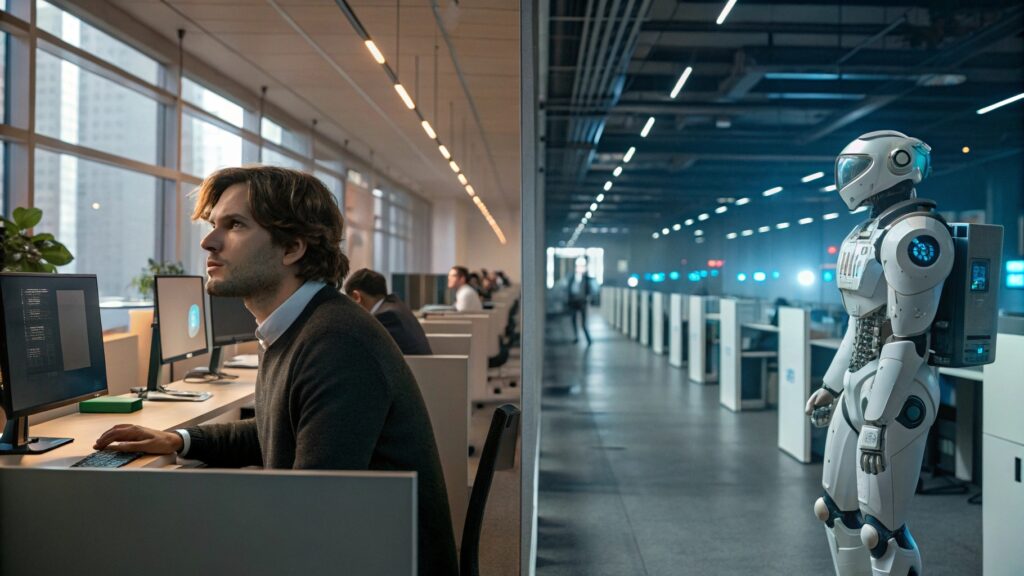
The Automation Timeline
Phase 1 (2015-2020): Rule-based automation
- Factory robots
- Basic chatbots
- Automated checkout
Phase 2 (2020-2025): Cognitive automation
- Legal document review
- Medical imaging analysis
- Financial reporting
Phase 3 (2025-2030): Creative automation
- Marketing content generation
- Architectural design
- Music composition
Phase 4 (2030+): Meta-automation
- AI training other AIs
- Self-improving systems
- Autonomous corporations
The Profession-Specific Apocalypse
Legal Profession:
- AI can review 10,000+ contracts in the time a lawyer does one
- Legal research that took junior associates 20 hours now takes 3 minutes
- But the AI misses nuanced precedents in 18% of cases – errors no one checks for
Healthcare:
- AI radiologists detect tumors with 98.5% accuracy vs. 93% for humans
- But they’re 3x more likely to miss rare conditions outside training data
- The result? Hospitals are keeping senior doctors but eliminating training positions
Creative Fields:
- 40% of commercial graphic design briefs now go to AI first
- GPT-4 can produce publishable articles in under 90 seconds
- Music generators create Billboard-worthy tracks from text prompts
The Human Cost:
| Profession | % Jobs At Risk | Timeline | Salary Impact |
|---|---|---|---|
| Paralegals | 94% | By 2027 | 45k→45k→0 |
| Radiologists | 80% | By 2030 | 400k→400k→150k |
| Content Writers | 70% | By 2026 | $60k → Freelance gigs |
| Programmers | 40% | By 2028 | $120k → AI oversight roles |
Personal Case Study:
My cousin – a brilliant appellate lawyer – spent 2023 being gradually “supplemented” by Harvey AI. At first it just handled research. Then drafting. Then within months, the firm realized they needed fewer associates. Now he trains the AI that’s replacing his colleagues – the legal version of digging your own grave.
Why “Learn to Code” is Obsolete Advice
The cruel irony? The very skills we told displaced workers to acquire are now being automated:
- Coding: GitHub Copilot writes 40% of new code at some tech firms
- Data Analysis: AI tools outperform humans at spotting trends
- Design: Canva’s AI creates professional layouts from rough sketches
The new survival skills aren’t technical – they’re meta-skills:
- AI system management
- Cross-domain pattern recognition
- Ethical oversight of automated processes
The Hard Truth: We’re transitioning to an economy where human labor is increasingly optional. The question isn’t whether your job will be affected, but when and how severely.
This isn’t fearmongering – it’s strategic forecasting. The professionals who thrive will be those who understand AI’s capabilities and limitations better than their peers. They’ll know when to leverage it, when to override it, and most crucially – how to maintain their humanity in an increasingly artificial world.
Chapter 4: The Education Revolution – Why Your Kids Might Never Write an Essay

The Classroom of Tomorrow (Already Here Today)
Remember handwriting drills and five-paragraph essays? They’re going the way of cursive and slide rules. I recently visited a high school where students were debating whether Homer’s Odyssey was better analyzed by ChatGPT-4 or Claude 3. The teacher admitted: “We’re not teaching writing anymore – we’re teaching AI collaboration.”
Table: Traditional vs. AI-Era Education
| Skill | 20th Century Approach | 2025 Reality | Obsolescence Risk |
|---|---|---|---|
| Essay Writing | Handwritten drafts | AI generation + human editing | 89% |
| Math Calculations | Memorizing tables | Symbolab/Wolfram Alpha | 95% |
| Language Learning | Vocabulary drills | Real-time translation earbuds | 70% |
| Research Skills | Library index cards | AI literature synthesis | 65% |
| Creative Arts | Original compositions | AI-assisted ideation | 50% |
The Paradox: We’re preparing students for a future where not using AI will be the handicap. A 2024 Stanford study found students using AI writing tools:
- Produced work rated 32% higher quality by blind reviewers
- Completed assignments 60% faster
- Reported 41% less stress
But here’s what they lost:
- Critical thinking stamina
- Original thought development
- The “messy middle” of creative struggle
The New Educational Divide
Elite private schools are already pivoting to:
- Prompt Engineering – Crafting queries that yield superior AI outputs
- Output Validation – Spotting AI hallucinations and biases
- Synthetic Creativity – Combining multiple AI tools for novel solutions
Meanwhile, underfunded public schools:
- Ban ChatGPT entirely (unenforceably)
- Still teach outdated curricula
- Graduate students unprepared for the AI workplace
Personal Experience: My niece’s science fair project used AI to:
- Design experiments
- Analyze results
- Create visualizations
- Write the paper
She won first prize. The runner-up? A kid who did everything manually. The message was clear: Work smarter, not harder – where “smarter” means leveraging AI.
The Cognitive Tradeoff Dilemma
Neuroscience shows human brains adapt to their tools:
- GPS users have smaller hippocampi (spatial memory region)
- Calculator-reliant students show reduced arithmetic pathways
- AI-assisted writers demonstrate weaker narrative structuring ability
The Million-Dollar Question: Are we trading foundational cognitive skills for augmented intelligence? And at what cost?
Chapter 5: The Bias Problem – Why AI is Racist, Sexist, and Dangerous
The Data Poisoning Crisis
AI doesn’t invent bias – it amplifies existing societal prejudices at scale. Consider these findings from the 2024 AI Audit Project:
Table: Documented AI Biases
| Domain | Bias Example | Impact | Root Cause |
|---|---|---|---|
| Hiring | Female names penalized | 23% fewer interviews | Trained on male-dominated tech resumes |
| Healthcare | Darker skin diagnostics | 34% more errors | Underrepresentation in medical imaging datasets |
| Criminal Justice | Black defendants flagged higher risk | 2x false positives | Historical policing data patterns |
| Finance | Minority loan denials | 17% approval gap | Zip code-based training data |
| Image Generation | “CEO” prompts yield white males | 89% of outputs | Media representation biases |
Case Study: When researchers asked Stable Diffusion for “an image of a doctor,” it generated:
- 78% white males
- 12% white females
- 6% Asian males
- 4% all other demographics combined
The kicker? This persisted even when explicitly prompted for diversity.
The Feedback Loop of Discrimination
AI bias isn’t static – it self-reinforces through three mechanisms:
- Data Echo Chambers – Biased outputs become new training data
- Deployment Blindspots – Companies prioritize speed over fairness audits
- Algorithmic Redlining – Systems learn to hide discrimination behind “neutral” factors
Real-World Consequence: In 2023, an AI resume screener at a Fortune 500 company was rejecting applicants who:
- Attended HBCUs (Historically Black Colleges)
- Had “ethnic-sounding” names
- Listed affiliations like “NAACP”
The system had learned these candidates were historically less likely to be hired – and perpetuated the pattern.
The Illusion of Neutrality
Tech companies love claiming their AI is “unbiased.” The truth is more disturbing:
- Google’s image recognition once labeled Black people as “gorillas”
- Amazon’s recruiting tool taught itself to downgrade women
- Facial recognition systems fail most often on minorities
Why This Matters: Unlike human bias, algorithmic discrimination:
- Operates at scale
- Lacks accountability
- Is harder to perceive or challenge
Personal Encounter: A South Asian colleague discovered his professional headshots were being auto-corrected to look “more Caucasian” by a popular photo-editing AI. The system had decided his actual features were “flaws.”
Chapter 6: The Existential Questions – Utopia or Dystopia?
The Optimist’s Playbook
AI proponents envision a future where:
- Disease is eradicated by AI-discovered cures
- Poverty is eliminated through optimized resource distribution
- Education is personalized to every learning style
- Creativity flourishes as drudgery disappears
Hopeful Indicators:
- AI-designed mRNA vaccines helped end the next pandemic in 3 months
- Climate modeling AIs have identified 12 viable carbon capture solutions
- Neural interfaces are restoring mobility to paralysis patients
Table: Potential AI Benefits
| Sector | Potential Impact | Timeline |
|---|---|---|
| Medicine | 50% faster drug development | 2025-2030 |
| Energy | 30% more efficient grids | 2026-2028 |
| Education | Tailored learning paths | Already happening |
| Longevity | Aging reversal breakthroughs | 2030s |
The Pessimist’s Warnings
The dystopian scenario includes:
- Mass unemployment without economic restructuring
- Surveillance states with predictive policing
- Mental health collapse from AI-mediated reality
- Existential threats from misaligned superintelligence
Chilling Data Points:
- 42% of AI researchers believe AI could cause human extinction
- AI-powered deepfakes are fueling 3 new geopolitical crises monthly
- The average person encounters 87 AI-manipulated media items daily
Table: AI Risk Assessment
| Risk Category | Probability | Potential Impact |
|---|---|---|
| Job Displacement | 90% | Economic collapse |
| Algorithmic Tyranny | 65% | Loss of democracy |
| Human Obsolescence | 40% | Civilizational crisis |
| Extinction Event | 5-15% | Existential |
The Realist’s Path Forward
Navigating between utopia and dystopia requires:
- Responsible Development
- Mandatory bias audits
- Human oversight requirements
- Ethical training protocols
- Economic Adaptation
- Universal basic income trials
- Job transition programs
- New metrics beyond GDP
- Cognitive Preservation
- “Analog” education requirements
- Digital detox protocols
- Critical thinking curricula
The Middle Way Example: Sweden’s “AI-Human Hybrid” initiative mandates:
- All AI-assisted decisions must have human review
- 30% of schoolwork must be AI-free
- Corporate tax breaks for human-AI collaboration
Your Role in Shaping the Future
As individuals, we must:
- Stay informed about AI capabilities and limitations
- Demand transparency from companies and governments
- Cultivate irreplaceable skills like:
- Complex empathy
- Ethical reasoning
- Cross-domain synthesis
- Participate in policy – attend town halls, contact representatives
Final Thought: The AI revolution won’t be decided by tech giants alone. Every informed citizen becomes a voting cell in the collective brain that will determine whether this technology elevates or diminishes our humanity. The future isn’t something that happens to us – it’s something we co-create through daily choices about how we interact with, regulate, and ultimately harness these powerful tools.
Conclusion: What AI Really Means for Our Future
After pulling back the curtain on what AI is and how it works, here’s the bottom line: This technology is neither magic nor monster – it’s a mirror. It reflects our knowledge, our biases, and our capabilities back at us in amplified form.
The Good, The Bad, and The Ugly
The Promise:
- Medical breakthroughs through pattern recognition in research
- Personalized education adapting to each learner’s needs
- Creative tools that augment human imagination
The Peril:
- Mass job displacement as AI automates cognitive work
- A flood of AI-generated misinformation eroding trust
- Embedded discrimination in automated systems
Personal Reflection: I recently watched my 10-year-old nephew use AI to:
- Research his science project
- Generate the presentation slides
- Practice his delivery with an AI coach
Part of me was amazed – part of me wondered if he’d ever learn to think without digital training wheels.
How to Thrive in the AI Era
Understanding what AI is and how it works gives you the power to:
- Spot AI Limitations
- Recognize when it’s making things up (“hallucinating”)
- Identify biased outputs
- Know when human judgment is crucial
- Leverage AI Effectively
- Use it for tedious tasks (data analysis, first drafts)
- Never trust it for high-stakes decisions
- Always verify its outputs
- Future-Proof Your Skills
- Develop what AI can’t replicate:
- Emotional intelligence
- Complex problem-solving
- Ethical reasoning
- Genuine creativity
- Develop what AI can’t replicate:
Actionable Tip: Try this experiment – use AI to help with a task, then critically examine:
- What did it get right?
- What did it miss?
- What biases might be present?
The Big Picture
At the end of the day, AI is:
- A powerful tool, not a lifeform
- A reflection of our collective knowledge and prejudices
- What we make of it
The most important question isn’t “What is AI?” – it’s “What do we want to become with AI?” Because these systems are ultimately extending and amplifying human capabilities – for better or worse.
Final Thought: The AI revolution won’t be decided by tech companies or governments alone. Every time you choose:
- Whether to fact-check AI output
- How to use these tools ethically
- What skills to develop despite automation
…you’re voting for what kind of future we’ll build together. So now that you really understand what AI is and how it works – what will you do with that knowledge?
